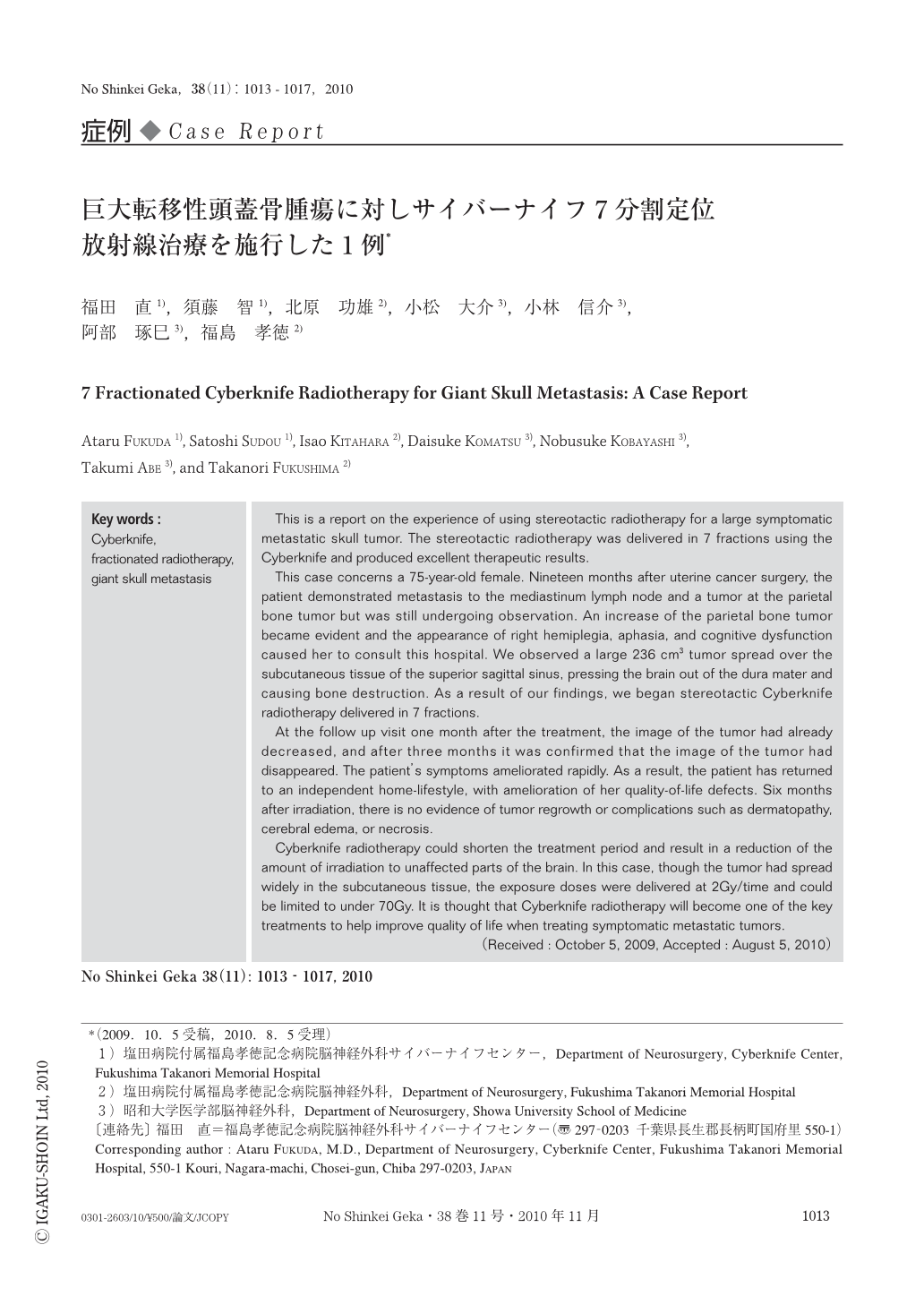Japanese
English
- 有料閲覧
- Abstract 文献概要
- 1ページ目 Look Inside
- 参考文献 Reference
Ⅰ.はじめに
癌治療の進歩により癌患者の生存期間が延びており,それに伴い転移性脳腫瘍を合併する患者も増加している.転移性脳腫瘍は癌のStageⅣの状態であり,生存期間中央値は1年程度であるものの,神経症状出現によるquality of life(QOL)低下を来すことから,生命予後も重要であるもののいかに神経症状の改善を得てQOLを向上させるかが,癌に対する全身治療の中での脳神経外科医の役割ではないかと考えている.
特にQOLの低下を招く症候性巨大転移性脳腫瘍に対しては全脳照射では腫瘍を制御することは困難であることが多く,ガンマナイフなどの単発照射では,10cm3以上の大きな腫瘍に関してはコントロール不良であることから6),6カ月以上の生命予後が期待される症例に関しては手術治療が選択されることが多い.
当院では全身状態や年齢などの条件から手術治療が困難と考えられた巨大症候性転移性脳腫瘍に対しサイバーナイフによる5~8分割定位放射線治療を施行してきた.その中で236cm3の巨大腫瘍に対し7分割定位放射線治療で良好な治療結果が得られた症例を経験したので報告する.
This is a report on the experience of using stereotactic radiotherapy for a large symptomatic metastatic skull tumor. The stereotactic radiotherapy was delivered in 7 fractions using the Cyberknife and produced excellent therapeutic results.
This case concerns a 75-year-old female. Nineteen months after uterine cancer surgery, the patient demonstrated metastasis to the mediastinum lymph node and a tumor at the parietal bone tumor but was still undergoing observation. An increase of the parietal bone tumor became evident and the appearance of right hemiplegia, aphasia, and cognitive dysfunction caused her to consult this hospital. We observed a large 236 cm3 tumor spread over the subcutaneous tissue of the superior sagittal sinus, pressing the brain out of the dura mater and causing bone destruction. As a result of our findings, we began stereotactic Cyberknife radiotherapy delivered in 7 fractions.
At the follow up visit one month after the treatment, the image of the tumor had already decreased, and after three months it was confirmed that the image of the tumor had disappeared. The patient's symptoms ameliorated rapidly. As a result, the patient has returned to an independent home-lifestyle, with amelioration of her quality-of-life defects. Six months after irradiation, there is no evidence of tumor regrowth or complications such as dermatopathy, cerebral edema, or necrosis.
Cyberknife radiotherapy could shorten the treatment period and result in a reduction of the amount of irradiation to unaffected parts of the brain. In this case, though the tumor had spread widely in the subcutaneous tissue, the exposure doses were delivered at 2Gy/time and could be limited to under 70Gy. It is thought that Cyberknife radiotherapy will become one of the key treatments to help improve quality of life when treating symptomatic metastatic tumors.

Copyright © 2010, Igaku-Shoin Ltd. All rights reserved.


